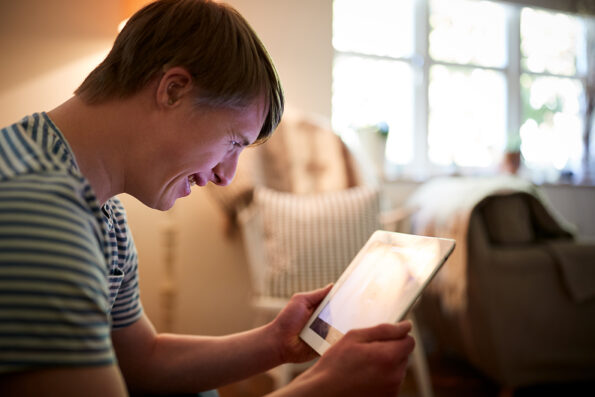I am Jake Harrison. I am studying an HND in Computing at Higher Education college. I am deaf and have two cochlear implants which help me to recognise sound. I rely heavily on lip reading and also use British Sign Language (BSL) and Sign Supported English (SSE) to understand people and to communicate. I also rely on captions on videos and for live video conferencing. I sometimes find it difficult to understand written English, especially if the language is technical and complex and the sentences are long. It helps me if there is a BSL interpretation as this breaks down the English and makes it easier and less stressful for me to understand.
Now that I am in Higher Education, I have a Disabled Students Allowance (DSA) which gives me the extra support I need to study. It meant that I could get a new laptop when I started my course which is very important especially now that so much of my learning is online because of the COVID 19 pandemic. I also have a Communication Support Worker (CSW) who interprets my tutor’s spoken English into BSL. She also supports me by making learning materials easier to understand and by helping me with my written assignments. One of the things I find very useful on my course is using eBooks. This is because I can highlight things in colour which makes it much easier for me to process and understand written English. Another thing which has been very helpful is the support of my peers, both hearing and hearing impaired. They have given me advice and strategies to help me with my studies, like keeping a record of all the resources I have found. This helps me because it saves me time doing all the extra work I have to do as a hearing impaired learner which makes me feel less frustrated.
“Learning is a positive experience for me when people and technology work together to help me overcome barriers.”
Learning is a positive experience for me when people and technology work together to help me overcome barriers. A good demonstration of this is online learning and video conferencing. When I get feedback on my assignments, for example, I work with my personal tutor and my CSW. My tutor shares his screen so that I can see my assignment and he uses colour to highlight information for me, such as red to show me information that I don’t need and yellow to show me when I need to change the sentence structure or tenses. I use the video of my tutor to lip read but also have my CSW on video at the same time so that I can see her BSL interpretation. Learning doesn’t work well and is frustrating and demotivating when technology and people create barriers which make it more difficult for me. When we first started using video conferencing calls to get feedback on my assignments, for example, as soon as my tutor shared his screen so that I could see my work, it meant that the video of him and my CSW were so small that I could not lip read or see the BSL interpretation. I got over this in the end by using two video conferencing services, with my tutor on MS Teams and my CSW on MS Skype. This meant that I could see the BSL interpretation on a full screen next to my assignment.
“Learning doesn’t work well and is frustrating and demotivating when technology and people create barriers which make it more difficult for me.”
Another example of when people and technology create barriers which makes my learning more difficult is captioning. This can be with live video conferencing or with videos which have had captions added to them. In video conferencing there is usually no option to choose the language that the automatic captioning is interpreting. It is often American English which makes it a lot less accurate at interpreting people who are speaking British English. The accuracy of live automatic captioning is a real problem because often there are so many mistakes that I can’t understand what is being said at all. The captions are also often too fast for me to read. This is why it is really helpful if people provide transcripts for live video calls and videos because the transcript is usually more accurate than the captions, and when I read them, I have more time to understand and process the information.
I find videos a really helpful way to learn because they make it easier for me to get a good understanding of a topic. If they don’t have captions though, this can make it very difficult or sometimes impossible for me to use them. This makes me feel totally isolated and left out because I am missing out on information which other people have access to. Another thing which I find very frustrating is if videos have captions, but people have relied on automatic captioning and not taken the time to make them useful for hearing impaired people. Automatic captions always have spelling and punctuation mistakes which make it more difficult for me to read and interpret what is being said. Another problem with them is that they don’t include important background information like sound effects. If there is more than one person talking, another issue with automatic captions is that they don’t make it clear who is saying what. This can make it impossible for me to understand what is happening. I often have to give up on watching videos which don’t have good captions because it is just pointless and a waste of my time.
“The one thing I would like people to take away from my experience is how much extra time and effort it takes for me to learn and to achieve the grades I want.”
The one thing I would like people to take away from my experience is how much extra time and effort it takes for me to learn and to achieve the grades I want. Technology and the way that people use it can make it easier for me to learn, or it can create more barriers which mean that I have to spend even more time and effort just to have the same access to learning as everyone else. If people understand how to use technology to meet the needs of all of their students, they can make the learning experience so much better. I also think that there is still much more that can be achieved in developing technology so that it benefits disabled people but also helps everyone. For example I would love to see text to speech functionality in video conferencing which could help hearing impaired people who might be struggling to speak, or automatic captions in different colours to show who is speaking. Another really important key to the success of video conferencing is developing internet access to make sure that everyone has good coverage.
This extract from Designing Accessible Learning Content by Susi Miller is ©2021 and is reproduced with permission from Kogan Page Ltd.
Ready to start your eLearning accessibility journey?
- Find out more about how to make your learning content accessible for users with a range of disabilities and impairments by ordering Designing Accessible Learning Content (opens in a new tab). Use the code AHR20 to receive a 20% discount.
- Find out more information and free resources on how to design learning content which includes learners with hearing access needs in our resources section.
- Find out more about the range of eLearning accessibility services we offer including: training, auditing and remediation, consultancy, speaking and advocacy and eLearning.
- Join the LinkedIn eLearning Accessibility Community (opens in a new tab).





Recent Comments